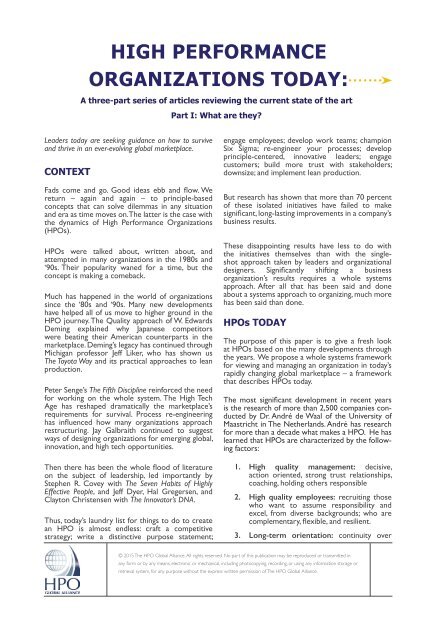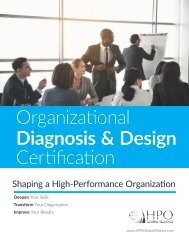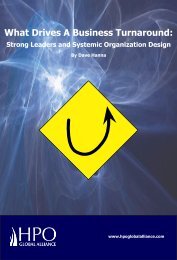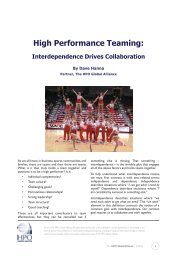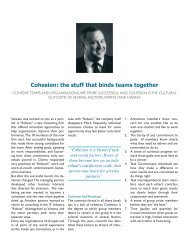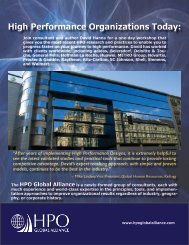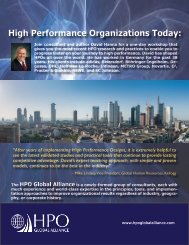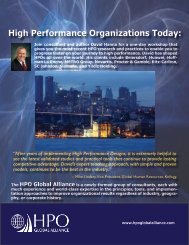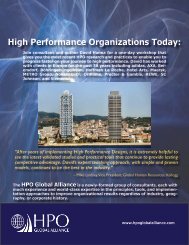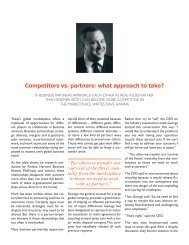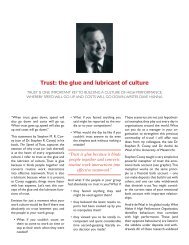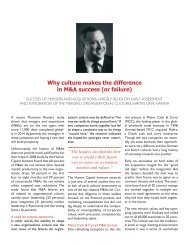HPOs Today Part 1 magazine
Part 1 of a series of articles that defines the latest views on what makes a High Performance Organization (HPO). This part focuses on the global study that validates HPO key factors. It includes case examples of Ritz-Carlton and Toyota as HPOs.
Part 1 of a series of articles that defines the latest views on what makes a High Performance Organization (HPO). This part focuses on the global study that validates HPO key factors. It includes case examples of Ritz-Carlton and Toyota as HPOs.
Create successful ePaper yourself
Turn your PDF publications into a flip-book with our unique Google optimized e-Paper software.
HIGH PERFORMANCE<br />
ORGANIZATIONS TODAY:<br />
A three-part series of articles reviewing the current state of the art<br />
<strong>Part</strong> I: What are they?<br />
Leaders today are seeking guidance on how to survive<br />
and thrive in an ever-evolving global marketplace.<br />
CONTEXT<br />
Fads come and go. Good ideas ebb and flow. We<br />
return – again and again – to principle-based<br />
concepts that can solve dilemmas in any situation<br />
and era as time moves on. The latter is the case with<br />
the dynamics of High Performance Organizations<br />
(<strong>HPOs</strong>).<br />
<strong>HPOs</strong> were talked about, written about, and<br />
attempted in many organizations in the 1980s and<br />
‘90s. Their popularity waned for a time, but the<br />
concept is making a comeback.<br />
Much has happened in the world of organizations<br />
since the ‘80s and ‘90s. Many new developments<br />
have helped all of us move to higher ground in the<br />
HPO journey. The Quality approach of W. Edwards<br />
Deming explained why Japanese competitors<br />
were beating their American counterparts in the<br />
marketplace. Deming’s legacy has continued through<br />
Michigan professor Jeff Liker, who has shown us<br />
The Toyota Way and its practical approaches to lean<br />
production.<br />
Peter Senge’s The Fifth Discipline reinforced the need<br />
for working on the whole system. The High Tech<br />
Age has reshaped dramatically the marketplace’s<br />
requirements for survival. Process re-engineering<br />
has influenced how many organizations approach<br />
restructuring. Jay Galbraith continued to suggest<br />
ways of designing organizations for emerging global,<br />
innovation, and high tech opportunities.<br />
Then there has been the whole flood of literature<br />
on the subject of leadership, led importantly by<br />
Stephen R. Covey with The Seven Habits of Highly<br />
Effective People, and Jeff Dyer, Hal Gregersen, and<br />
Clayton Christensen with The Innovator’s DNA.<br />
Thus, today’s laundry list for things to do to create<br />
an HPO is almost endless: craft a competitive<br />
strategy; write a distinctive purpose statement;<br />
engage employees; develop work teams; champion<br />
Six Sigma; re-engineer your processes; develop<br />
principle-centered, innovative leaders; engage<br />
customers; build more trust with stakeholders;<br />
downsize; and implement lean production.<br />
But research has shown that more than 70 percent<br />
of these isolated initiatives have failed to make<br />
significant, long-lasting improvements in a company’s<br />
business results.<br />
These disappointing results have less to do with<br />
the initiatives themselves than with the singleshot<br />
approach taken by leaders and organizational<br />
designers. Significantly shifting a business<br />
organization’s results requires a whole systems<br />
approach. After all that has been said and done<br />
about a systems approach to organizing, much more<br />
has been said than done.<br />
<strong>HPOs</strong> TODAY<br />
The purpose of this paper is to give a fresh look<br />
at <strong>HPOs</strong> based on the many developments through<br />
the years. We propose a whole systems framework<br />
for viewing and managing an organization in today’s<br />
rapidly changing global marketplace – a framework<br />
that describes <strong>HPOs</strong> today.<br />
The most significant development in recent years<br />
is the research of more than 2,500 companies conducted<br />
by Dr. André de Waal of the University of<br />
Maastricht in The Netherlands. André has research<br />
for more than a decade what makes a HPO. He has<br />
learned that <strong>HPOs</strong> are characterized by the following<br />
factors:<br />
1. High quality management: decisive,<br />
action oriented, strong trust relationships,<br />
coaching, holding others responsible<br />
2. High quality employees: recruiting those<br />
who want to assume responsibility and<br />
excel, from diverse backgrounds; who are<br />
complementary, flexible, and resilient.<br />
3. Long-term orientation: continuity over<br />
© 2015 The HPO Global Alliance. All rights reserved. No part of this publication may be reproduced or transmitted in<br />
any form or by any means, electronic or mechanical, including photocopying, recording, or using any information storage or<br />
retrieval system, for any purpose without the express written permission of The HPO Global Alliance.


